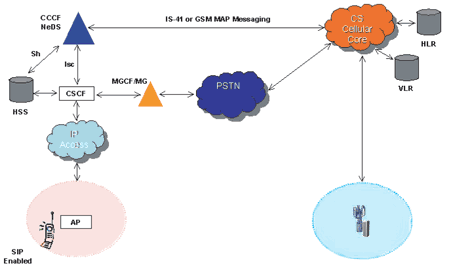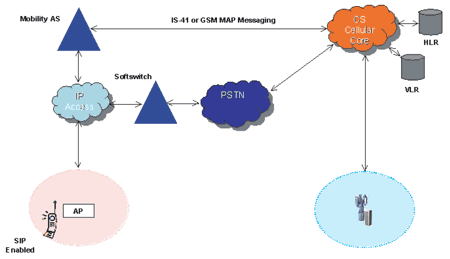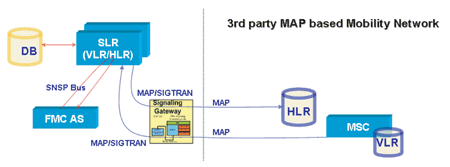FMC Options, Questions and Solutions
Keep an eye on the mobility application server, multiple touchpoints of convergence, numbering systems and interoperability as the industry moves toward IMS/PacketCable 2.0-based fixed-mobile convergence. For many years, CableLabs and cable industry veterans have been designing PacketCable, the open architecture blueprint for fixed voice and multimedia over broadband cable networks. The simultaneous rise of wireless voice over Internet protocol (VoIP) technologies has led to an inter-working of fixed and/or wireless devices and networks known as fixed-mobile convergence (FMC). Driven by the constraints of cellular infrastructure and the opportunities of improved quality of service in the home and new IP-based multimedia applications, the movement toward FMC has led the cable industry to re-evaluate network architectures; anticipate convergence in consumer devices, applications and respective networks; and engage in lesson-learning trials. FMC is clearly a work in progress, but significant takeaways at this point in the story include the role of transitional elements, such as the mobility application server, leading to PacketCable 2.0; the multiple and layered touchpoints of convergence; and the importance as seen in early trials of numbering systems and interoperability. FMC architectures Currently, there are three major architectural approaches to FMC: unlicensed mobile access (UMA), a solution deemed temporary at best; pre-PacketCable 2.0, which adds a mobility application server (AS) to the cable network; and IP multimedia subsystem (IMS), a standard under development by the Third Generation Partnership Project, which CableLabs has decided to incorporate into PacketCable 2.0. UMA. Developed by a cellular industry partnership, UMA extends the circuit-switched global system for mobile communication (GSM) network into unlicensed IP networks. This technology has now moved into the 3GPP standards body. The first offerings of UMA are Bluetooth-based, but they are quickly evolving to Wi-Fi enabled handsets. In this architecture the UMA network controller (UNC) emulates the base station controller (BSC) interface into the GSM core. From the IP access network side, the UNC terminates an IP security (IPsec) encrypted tunnel from the handset. This tunnel is used to backhaul cellular signaling and real-time protocol (RTP) voice packets into the GSM network. The UNC is responsible for converting the GSM signaling and RTP into an interface-compliant time division multiplexing (TDM) stream. In the UMA architecture, all of the public switched telephone network (PSTN) traffic is typically terminated at the mobile carrier. The subscriber is a cellular subscriber with a cellular set of services. It is difficult for the fixed operator to participate in the value chain by limiting the amount of subscriber control. As a result, UMA is widely regarded as a temporary solution, one that still needs to leverage expensive circuit switch investments and that will be replaced by an IMS-based solution. Pre-PacketCable 2.0. These architectures are being developed to provide an evolution path to full PacketCable 2.0 or IMS. They are designed to integrate with today’s softswitch architectures, therefore allowing for FMC service offerings before full PacketCable 2.0 deployment. The new element in this FMC architecture is referred to as a mobility application server (AS). This server has two main interfaces. On the IP side of the network, it is a session initiation protocol (SIP) proxy and registrar, or in some implementations, a SIP redirect proxy. From the cellular network’s perspective, this server looks like another mobile switching center (MSC) visitor location register (VLR) combination. Its function is to enable cellular subscribers to roam into the IP network. A home location register (HLR), included in advanced mobility application server solutions, allows the cable operator to own and provision its FMC subscribers. Subscribers that are provisioned in the cable operator’s HLR then roam onto the cellular network when an IP connection is unavailable. The roaming scenarios are enabled by an IS-41 or GSM mobility application protocol (MAP) interface between the fixed and mobile operators. This connection is based on cellular standards and has been in use for many years for roaming between cellular operators and often even within a single operator’s network. The traffic on this link is used for authentication, user profile exchange, location processing, call completion, etc. This architecture enables bidirectional roaming between the cellular and fixed operator using a single set of user credentials. A user may be reached via a single phone number, independent of the access technology in use. VoIP-based, pre-PacketCable 2.0 architectures enable the cable operator to participate in the value chain by giving it the opportunity to provision subscribers and the services they receive. This architecture also is currently available and offers a clear evolution path to PacketCable 2.0. IMS/PacketCable. IMS is being architected by the members of the 3GPP and adapted by CableLabs members for use in DOCSIS networks. PacketCable 2.0 is an all-IP, SIP-based, layered architecture that enables service delivery in an access-agnostic manner. The layers of this architecture are service, control and transport. Applications reside in the service layer. Switching, quality of service (QoS), subscriber data and gateway function reside in the control layer. The access layer can range from DOCSIS to WiMAX, but the goal is for the core to be access-technology independent. This architecture, shown in Figure 1, is designed to offer access-agnostic delivery of applications to the end user. The core network is SIP-based with inter-working functions for interfacing to the PSTN, circuit-switch cellular network, etc. In this architecture, the key enabler of FMC is the call continuity control function (CCCF) and network domain selection (NeDS). These two functional elements are referred to as the voice call continuity application server. The CCCF is a back-to-back user agent that interfaces with the PacketCable 2.0 over the line control signaling (LSC) interface. The CCCF also has a DIAMETER interface into the home subscriber server for the purpose of exchanging user subscription data. Network domain selection provides a control mechanism for access network selection and handover authorization. 
Figure 1 The CCCF interfaces with the circuit-switched cellular networks over SS7 as the mobility AS did in the pre-PacketCable 2.0 architecture described previously. This interface allows for roaming into circuit-switched cellular networks and for cable operator subscriber ownership. Compare and contrast There are differences and similarities among these architectures. One of the key points is the similarity between the pre-PacketCable 2.0 architecture and full PacketCable 2.0. The interface between the CCCF and the IMS core is similar to the mobility AS and softswitch interface in that they are both SIP-based. A major area of difference between the architectures is the level of subscriber ownership that is available and the ability to add new services. UMA provides very little opportunity for value-added services from the fixed operator’s point of view. The SIP-based architectures that include an HLR allow for maximum flexibility in provisioning users and adding new services. The SIP-based solutions also allow cable operators to leverage their existing IP infrastructure. As previously discussed, PacketCable 2.0 is leveraging the IMS architecture. In this architecture, the network layer and applications need not be replicated for each type of access technology. One of the main motivators for moving from the siloed architectures of today is to simplify the delivery of applications to the end user. Standardized interfaces into the application layer make it easy to add revenue-generating applications. Multiple convergences Beyond architectural issues, when it comes to real-world deployment of FMC convergence, there are additional questions—and possible answers—that range across the areas of customer premises, applications and multiple services networks. In light of the difficulties related to network address translation (NAT), user authentication, encryption, and end-to-end QoS, for instance, the cable community has an opportunity to simplify and enhance a subscriber’s experience by deploying converged devices in the home. A converged EMTA that is managed by the operator can provide guaranteed QoS in the home using Wi-Fi multimedia, which is based on the 802.11 specification. This level of QoS assurance can be tied to the DOCSIS QoS mechanisms. The Wi-Fi enabled EMTA also will contain intelligence to authenticate and encrypt access layer traffic from dual-mode devices. On the applications front, two apps that will follow voice to help make a user’s experience seamless are “dynamic wireline-wireless” and “join.” Dynamic wireline-wireless convergence is the idea of integrating users’ home phone service with their mobile experience. When a user enters home Wi-Fi coverage, for instance, an intelligent network with this functionality will notify the home phone when a user’s mobile number is dialed. It will also notify a user’s dual-mode mobile when the home number is dialed. Join is another useful voice application. Multi-party calls, while familiar today, aren’t readily available in an all-IP wireless paradigm. The join application addresses this issue by tracking all of the active calls out of a home and allowing users to add themselves into an active call. Among the media applications likely to prove popular are personal video player functionality and live broadcast of audio and or video content. Enabling such functions over dual-mode handsets will be challenging enough, but in looking at multimedia services over wireless, handsets are only one among many. Consumer electronics stores are full of devices that have the right functionality to be multimedia wireless devices, yet are not wireless enabled. A wireless MobileCard (such as that proposed by the Kantan Alliance) modem could solve that problem. As for interconnected cellular and cable networks, it is useful to point out once again the role of the mobility AS. Figure 2 depicts a pre-PacketCable 2.0 mobility AS that interfaces with the cable operator’s softswitch via a SIP-based interface. It interfaces with the cellular network via an SS7 connection that transports GSM or IS-41 MAP, depending on what form of technology the mobile network operator is using. The mobility AS supports an integrated HLR and VLR, which enables bidirectional roaming between the operators and allows for cable operator subscriber ownership. 
Figure 2 While not shown in Figure 2, a trunk between the mobile operator and the cable operator would typically be deployed. A direct trunk is meant to enable voice traffic between the two networks for the purpose of least cost routing. This would enable the operators to offer free calling between their mobile and fixed subscriber bases. Figure 3 depicts more precisely the interaction between the mobile network and the mobility AS. The interaction between the mobility AS and the cellular network’s HLR and VLR is MAP over SS7. MAP is used to for user authentication, updating the location of a subscriber, sharing subscription information between networks, and routing calls to users that are roaming. As an example, when a fixed subscriber roams into the cellular network, the cellular VLR communicates with the FMC AS’s HLR to authenticate the user and determine which services are available. Once this user is configured in the VLR, he or she is capable of sending and receiving calls. 
Figure 3 On an incoming call to the roaming user, the mobility AS server sends a provide-roaming-number-MAP message to the visited VLR. The VLR returns a roaming number, and the FMC AS forwards the incoming call to that number. In addition to these points of AS-specific connectivity, to the extent that cable operators want a high level of integration in an FMC offering, they will need to create relationships with their wireless partners that also include SS7 interconnectivity, call data record (CDR) clearing and (as indicated earlier) trunk interconnect. Toward FMC FMC is a key enabler to the quad-play strategy. The opportunity exists to improve the economics of a simple cellular resell while improving QoS in the home. FMC will be an enabler for many new IP-based multimedia ideas, opening up opportunities in application, device and services markets for cable operators. Subscribers are more likely to choose a next-generation network that can combine reliable high capacity location-based pipes with innovative fixed and mobile devices. FMC technology is viable today for market trials, evaluation, and first deployments. (See sidebars for summaries of two trials.) The right choices now will facilitate an operator’s FMC evolution to a profitable PacketCable 2.0 (IMS) core network while making the most of existing infrastructure. This solution provides the cable operator a platform to deploy next-generation applications today with a roadmap to PacketCable standards. Jay Bestermann is senior manager, FMC Product Development, Arris International. Reach him at Jay.Bestermann@arrisi.com. Jack Fijolek is senior director Strategic Business Development, UTStarcom. Reach him at Jack.Fijolek@utstar.com. This article was drawn from a longer paper presented at an FMC workshop at this year’s SCTE Cable-Tec Expo.
Sidebar 1 Brazil Telecom Trial: Single or Dual Number? One case analysis is a Brazil Telecom trial in South America where the operator owns both the fixed line operation and a GSM mobile network with 10 million fixed-line users and 2 million mobile users. The fixed line operation incorporates NGN, and Brazil Telecom already has a softswitch-based network. The purpose of this trial was to gather information on which domain should own the FMC subscriber and whether a single number or dual number system works best. Lessons Learned The single number has the user benefit of ubiquitous access and the service provider benefit of simple configuration using existing treatment for roaming. The dual number system offers the most flexibility for operator partnership, particularly in cases where both the fixed and mobile number are owned by the NGN domain and incoming calls to either number are routed to the softswitch and where the NGN domain owns the fixed number and the GSM domain owns the mobile number.
Sidebar 2 European MSO Trial: Interoperability This case analysis is an exposure convergence technology trial in Europe where the cable operator provides the VoIP fixed line operation and a GSM mobile operator provides the mobile network. The purpose of this trial is to demonstrate and exercise elements of interoperability with the existing switching infrastructure. Lessons Learned Interoperability, even in a standards-based world, is challenging. The connection between the mobility application server and the existing switching infrastructure is a SIP trunking interface. Several interoperability issues required either provisioning adjustments or implementation of patches to solve noncompliant SIP implementations. Most problems stemmed from incorrect provisioning. Note that adding mobility to a cable operator’s network brings in another entire grammar: global title translation, international mobile subscriber identities, and roaming numbers; these are among the many new terms on the FMC learning curve.